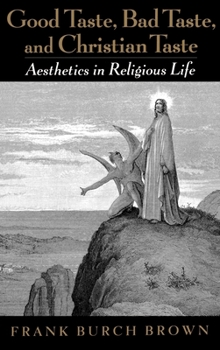Good Taste, Bad Taste, and Christian Taste: Aesthetics in Religious Life
Select Format
Select Condition 
Book Overview
Christians frequently come into conflict with themselves and others over such matters as music, popular culture, and worship style. Yet they usually lack any theology of art or taste adequate to deal with aesthetic disputes. In this provocative book, Frank Burch Brown offers a constructive, "ecumenical" approach to artistic taste and aesthetic judgment--a non-elitist but discriminating theological aesthetics that has "teeth but no fangs."
While...
Format:Hardcover
Language:English
ISBN:019513611X
ISBN13:9780195136111
Release Date:September 2000
Publisher:Oxford University Press
Length:336 Pages
Weight:0.05 lbs.
Dimensions:1.1" x 6.4" x 9.5"
Customer Reviews
2 ratings
Take a bite...
Published by Thriftbooks.com User , 21 years ago
Frank Burch Brown is one of the star professors of my seminary. One of the things that made me select the seminary was their interest in aesthetics, the arts and theology, and by the arts, we mean a wide variety of arts -- architecture, visual arts, music, drama, and more. Frank Burch Brown does credit to this range of the arts in his text.First, perhaps a word on the title is fitting. By 'taste', Brown does not mean necessarily to imply preference or status in an elitism way, although well aware that this particular meaning will likely be the first one perceived. Rather, think of 'taste' as an action, something one does, like taking a bite of an apple -- art is too often a passive construct in modern society; Brown calls upon the individual or community experiencing art to participate with it. This is particularly important in church communities, whose ideas of art and the relative value of the same vary widely.Taste, Brown states, is something intimately connected to morality and to religious feeling and belief. One can see this demonstrated both in reactions to museum displays that are controversial as well as the critique Christians give to each other about church architecture, hymnody, or vestment and design styles. Brown shares in-depth theological analysis well supported and supplemented with historical information, talking about the good and the bad throughout the experience of Christendom as it relates back to modern experience. However, this is not a history text either in form or function. Perhaps the strongest section Brown presents is on music; music has become a vital piece of worship for many, sometimes the sine qua non of worship. Also, Brown's artistic background in strong in music, as he is a composer in addition to professor and writer. Music is one of the most community-building and the most divisive of elements in modern worship practice -- anyone who has dared suggest a different style of hymn in church can attest to this! In music as a case study one can see the different pieces that go into determining taste across age, culture and social lines.Perhaps the most novel and entertaining section is chapter five, dealing with Kitsch, Sacred and Profane -- the question of quality. In amusing but instructive fashion, Brown compares the Hagia Sophia and the early Russians' experience of it with the Precious Moments Chapel in Missouri, and how both have value but both can also be suspect in different frameworks. The difficulty of dealing with kitsch, to a large extent determined by the mass-marketability and commodity-nature of the offerings, is an instructive one; kitsch is designed to easily produce a response, often in a base or 'cheap' manner, as often occurs with the million-plus visitors to the chapel of tear-drop eyed children.In the final chapters, Brown offers a critique of the current situation, from which Christians of all backgrounds may draw inspiration and none escape the occasional tweak. Brown also o
O Taste and See
Published by Thriftbooks.com User , 21 years ago
Good Taste, Bad Taste, and Christian Taste, by Frank Burch Brown, a slow read at first, evolves into a very reasoned and interesting look at how the church regards the arts, and how the arts regards the church. Do not be put off by the elitist sounding title of the book. Brown uses the word "taste" as "to savor" and "to experience" much as the psalmist does in Psalm 34:8. The title is intentionally deceptive.Interestingly, the author utilizes the terms religious and sacred somewhat ambiguously, without clearly defining a distinction between the reality of the institutional church and the "holy". As a composer of church music himself, Brown is clearly more pragmatic in his discussion of the musical art, but resolute in an absolute consideration of other arts. His chapter on "kitsch" is especially refreshing and enjoyable to read, and his analysis of today's worship wars is well thought out and objective. One caveat concerns Brown's approach to the subject of worship itself, which is here treated as a passive event in which the worshipper is a bystander. For Brown's purposes, this may make sense, as this puts music, as an art, on the same plain as the other arts (also considered here) in which performance is not an opportunity. Worship, however, is an act of the church in which all present participate. The unique aesthetics of the participant and performer of worship and the lively arts is perhaps a subject for another book. I recommend this book highly for all church leaders: clergy and laity alike. Tragedy is, those who really need to hear the wisdom of this book, will never read it.





